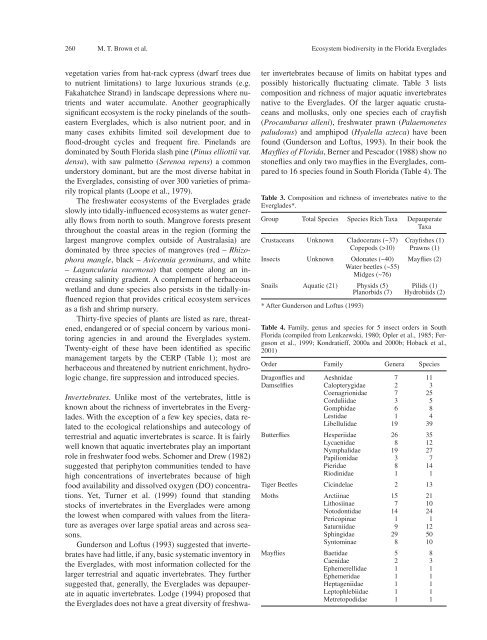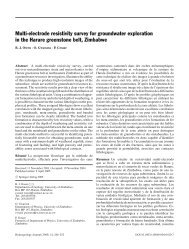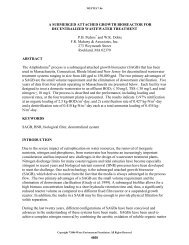Species diversity in the Florida Everglades, USA - Environmental ...
Species diversity in the Florida Everglades, USA - Environmental ...
Species diversity in the Florida Everglades, USA - Environmental ...
You also want an ePaper? Increase the reach of your titles
YUMPU automatically turns print PDFs into web optimized ePapers that Google loves.
260 M. T. Brown et al. Ecosystem bio<strong>diversity</strong> <strong>in</strong> <strong>the</strong> <strong>Florida</strong> <strong>Everglades</strong><br />
vegetation varies from hat-rack cypress (dwarf trees due<br />
to nutrient limitations) to large luxurious strands (e.g.<br />
Fakahatchee Strand) <strong>in</strong> landscape depressions where nutrients<br />
and water accumulate. Ano<strong>the</strong>r geographically<br />
signifi cant ecosystem is <strong>the</strong> rocky p<strong>in</strong>elands of <strong>the</strong> sou<strong>the</strong>astern<br />
<strong>Everglades</strong>, which is also nutrient poor, and <strong>in</strong><br />
many cases exhibits limited soil development due to<br />
fl ood-drought cycles and frequent fi re. P<strong>in</strong>elands are<br />
dom<strong>in</strong>ated by South <strong>Florida</strong> slash p<strong>in</strong>e (P<strong>in</strong>us elliottii var.<br />
densa), with saw palmetto (Serenoa repens) a common<br />
understory dom<strong>in</strong>ant, but are <strong>the</strong> most diverse habitat <strong>in</strong><br />
<strong>the</strong> <strong>Everglades</strong>, consist<strong>in</strong>g of over 300 varieties of primarily<br />
tropical plants (Loope et al., 1979).<br />
The freshwater ecosystems of <strong>the</strong> <strong>Everglades</strong> grade<br />
slowly <strong>in</strong>to tidally-<strong>in</strong>fl uenced ecosystems as water generally<br />
fl ows from north to south. Mangrove forests present<br />
throughout <strong>the</strong> coastal areas <strong>in</strong> <strong>the</strong> region (form<strong>in</strong>g <strong>the</strong><br />
largest mangrove complex outside of Australasia) are<br />
dom<strong>in</strong>ated by three species of mangroves (red – Rhizophora<br />
mangle, black – Avicennia germ<strong>in</strong>ans, and white<br />
– Laguncularia racemosa) that compete along an <strong>in</strong>creas<strong>in</strong>g<br />
sal<strong>in</strong>ity gradient. A complement of herbaceous<br />
wetland and dune species also persists <strong>in</strong> <strong>the</strong> tidally-<strong>in</strong>fl<br />
uenced region that provides critical ecosystem services<br />
as a fi sh and shrimp nursery.<br />
Thirty-fi ve species of plants are listed as rare, threatened,<br />
endangered or of special concern by various monitor<strong>in</strong>g<br />
agencies <strong>in</strong> and around <strong>the</strong> <strong>Everglades</strong> system.<br />
Twenty-eight of <strong>the</strong>se have been identifi ed as specifi c<br />
management targets by <strong>the</strong> CERP (Table 1); most are<br />
herbaceous and threatened by nutrient enrichment, hydrologic<br />
change, fi re suppression and <strong>in</strong>troduced species.<br />
Invertebrates. Unlike most of <strong>the</strong> vertebrates, little is<br />
known about <strong>the</strong> richness of <strong>in</strong>vertebrates <strong>in</strong> <strong>the</strong> <strong>Everglades</strong>.<br />
With <strong>the</strong> exception of a few key species, data related<br />
to <strong>the</strong> ecological relationships and autecology of<br />
terrestrial and aquatic <strong>in</strong>vertebrates is scarce. It is fairly<br />
well known that aquatic <strong>in</strong>vertebrates play an important<br />
role <strong>in</strong> freshwater food webs. Schomer and Drew (1982)<br />
suggested that periphyton communities tended to have<br />
high concentrations of <strong>in</strong>vertebrates because of high<br />
food availability and dissolved oxygen (DO) concentrations.<br />
Yet, Turner et al. (1999) found that stand<strong>in</strong>g<br />
stocks of <strong>in</strong>vertebrates <strong>in</strong> <strong>the</strong> <strong>Everglades</strong> were among<br />
<strong>the</strong> lowest when compared with values from <strong>the</strong> literature<br />
as averages over large spatial areas and across seasons.<br />
Gunderson and Loftus (1993) suggested that <strong>in</strong>vertebrates<br />
have had little, if any, basic systematic <strong>in</strong>ventory <strong>in</strong><br />
<strong>the</strong> <strong>Everglades</strong>, with most <strong>in</strong>formation collected for <strong>the</strong><br />
larger terrestrial and aquatic <strong>in</strong>vertebrates. They fur<strong>the</strong>r<br />
suggested that, generally, <strong>the</strong> <strong>Everglades</strong> was depauperate<br />
<strong>in</strong> aquatic <strong>in</strong>vertebrates. Lodge (1994) proposed that<br />
<strong>the</strong> <strong>Everglades</strong> does not have a great <strong>diversity</strong> of freshwa-<br />
ter <strong>in</strong>vertebrates because of limits on habitat types and<br />
possibly historically fl uctuat<strong>in</strong>g climate. Table 3 lists<br />
composition and richness of major aquatic <strong>in</strong>vertebrates<br />
native to <strong>the</strong> <strong>Everglades</strong>. Of <strong>the</strong> larger aquatic crustaceans<br />
and mollusks, only one species each of crayfi sh<br />
(Procambarus alleni), freshwater prawn (Palaemonetes<br />
paludosus) and amphipod (Hyalella azteca) have been<br />
found (Gunderson and Loftus, 1993). In <strong>the</strong>ir book <strong>the</strong><br />
Mayfl ies of <strong>Florida</strong>, Berner and Pescador (1988) show no<br />
stonefl ies and only two mayfl ies <strong>in</strong> <strong>the</strong> <strong>Everglades</strong>, compared<br />
to 16 species found <strong>in</strong> South <strong>Florida</strong> (Table 4). The<br />
Table 3. Composition and richness of <strong>in</strong>vertebrates native to <strong>the</strong><br />
<strong>Everglades</strong>*.<br />
Group Total <strong>Species</strong> <strong>Species</strong> Rich Taxa Depauperate<br />
Taxa<br />
Crustaceans Unknown Cladocerans (~37) Crayfi shes (1)<br />
Copepods (>10) Prawns (1)<br />
Insects Unknown Odonates (~40)<br />
Water beetles (~55)<br />
Midges (~76)<br />
Mayfl ies (2)<br />
Snails Aquatic (21) Physids (5)<br />
Planorbids (7)<br />
Pilids (1)<br />
Hydrobiids (2)<br />
* After Gunderson and Loftus (1993)<br />
Table 4. Family, genus and species for 5 <strong>in</strong>sect orders <strong>in</strong> South<br />
<strong>Florida</strong> (compiled from Lenkzewski, 1980; Opler et al., 1985; Ferguson<br />
et al., 1999; Kondratieff, 2000a and 2000b; Hoback et al.,<br />
2001)<br />
Order Family Genera <strong>Species</strong><br />
Dragonfl ies and Aeshnidae 7 11<br />
Damselfl ies Calopterygidae 2 3<br />
Coenagrionidae 7 25<br />
Corduliidae 3 5<br />
Gomphidae 6 8<br />
Lestidae 1 4<br />
Libellulidae 19 39<br />
Butterfl ies Hesperiidae 26 35<br />
Lycaenidae 8 12<br />
Nymphalidae 19 27<br />
Papilionidae 3 7<br />
Pieridae 8 14<br />
Riod<strong>in</strong>idae 1 1<br />
Tiger Beetles Cic<strong>in</strong>delae 2 13<br />
Moths Arcti<strong>in</strong>ae 15 21<br />
Lithosi<strong>in</strong>ae 7 10<br />
Notodontidae 14 24<br />
Pericop<strong>in</strong>ae 1 1<br />
Saturniidae 9 12<br />
Sph<strong>in</strong>gidae 29 50<br />
Syntom<strong>in</strong>ae 8 10<br />
Mayfl ies Baetidae 5 8<br />
Caenidae 2 3<br />
Ephemerellidae 1 1<br />
Ephemeridae 1 1<br />
Heptageniidae 1 1<br />
Leptophlebiidae 1 1<br />
Metretopodidae 1 1
















